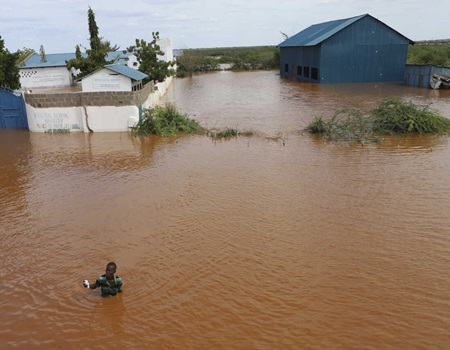Thousands of Kenyan Students still Out of School Due to April-May Floods: A survey conducted in June 2024 revealed the devastating impact of floods on Kenya’s education sector. The survey shows that 15,000 students missed school due to the disaster. The rapid assessment covered 60 schools across nine counties. It highlighted the severe challenges facing education in the flood’s aftermath.
62 Primary schools were submerged
The Elimu Bora Working Group found that over 62 primary schools were submerged, endangering 15,000 students.
In the Tana River region, 34 cholera cases and damage to over 20,000 toilets exacerbated health risks. Student enrollment dropped significantly, with numbers falling from 23,530 to 21,453—a 9% decrease due to the floods.
Female students saw a 10% decline in return rates. A further 11% of students with special needs, or 40 out of 337, had not yet returned to school.
The floods particularly affected girls and students with special needs.
Infrastructure damage
The infrastructure damage was extensive, leaving many schools with non-functional facilities.
SEE ALSO: Four Main Reasons why TSC will reject a Teacher’s Transfer Request
Some buildings, despite being unsafe, were still in use due to a lack of alternatives. Most schools were unprepared for teaching and learning when they reopened in May 2024.
Previously, some schools had served as IDP camps. Displaced individuals were moved to temporary structures on higher ground once schools reopened.
Collapsed latrines and damaged water sources posed severe health risks. There was also a lack of mental health and psychosocial support for affected students, teachers, and staff.
The Tana River region reported 34 cholera cases, raising concerns about potential outbreaks.
Lack of disaster response
The survey highlighted a lack of disaster response and coordination frameworks across the assessed sub-counties.
The absence of proper disaster response plans hindered effective crisis management and delayed responses during emergencies.
Existing rapid response mechanisms were inadequate, failing to mitigate disasters effectively. This also impeded accurate and timely data collection at school, local, and sub-county levels.
Alarmingly, less than 20% of schools surveyed received government aid for reconstruction or repairs. Many students returned to school weeks late. This was because of impassable roads, causing them to fall behind in their studies.
Schools, teachers, non-teaching staff, students, and communities were largely unprepared for reopening. This was mainly because of widespread destruction and lack of repairs in essential facilities.
The government must establish a structured school infrastructure development plan.
The survey recommended establishing a structured school infrastructure development, improvement, and maintenance program.
It also proposed a collaborative, multi-stakeholder recovery approach after disasters. The approach must incorporate flood mitigation measures into physical planning systems.
SEE ALSO: TSC Requirements for Recruiting and Deploying Teachers at TTC
Additionally, ongoing training and capacity development programs focused on disaster preparedness, prevention, response, and mitigation were advised.
Catastrophic impact of the floods
The April-May 2024 floods had a catastrophic impact on Kenya. The floods left hundreds dead, many displaced, and extensive damage to schools, homes, roads, and bridges.
As of May 10, 2024, the National Disaster Operations Centre reported 267 fatalities, 188 injuries, and 75 missing persons.
Approximately 281,835 people (56,367 families) were displaced. Nearly 380,573 individuals (76,114 families) affected by persistent heavy rains and flooding.
The floods resulted in the loss of over 9,973 livestock, damage to 41,562 acres of cropland, and destruction of 61 roads.
Additionally, 886 businesses, 1,967 schools, 1,465 water sources, and 62 health facilities were damaged in 11 of the 42 affected counties.
The Kenyan government announced that Sh1 billion (US$7.5 million) was needed to rehabilitate flood-affected schools.
The survey underscored the urgency for proper drainage systems and elevated construction to mitigate future flood risks.
READ ALSO:
Basic Salary and Allowances for TSC Chief Principals, Grade D5
Five New Factors TSC Considers before Immediate Approval of Teacher Transfers
Details of Phase 2 Salary Increment for Teachers in July 2024
How Senior Schools Will Implement Career Paths from Grade 10
All TSC Teachers to pay KES 2500 for this Mandatory Training
Why TSC will not Promote This Group of Teachers in Future
TSC Releases Two Types of Letters Following Promotion Results
Breakdown of Enhanced Salaries for the Newly Promoted TSC Teachers
How to Change Name on KCPE Certificate
How to Pick TSC Promotion Letters Released to County offices
Revised 2024 Co-curricular Activities Calendar for Kenyan Schools
TSC Sets These New Conditions for Teachers Seeking Transfers
How to Create a TSC TPAD Account on https://tpad2.tsc.go.ke/
TSC Deployment from Primary to JSS, All Requirements
How to View and Download Latest TSC Payslip Online
How to Apply for Maternity Leave on the TSC Online Leave Application Portal
Final List of 36200 Successful TSC Promotion Applicants 2024
How to Upload Mandatory evidence on TSC TPAD
Thousands of Kenyan Students still Out of School Due to April-May Floods
